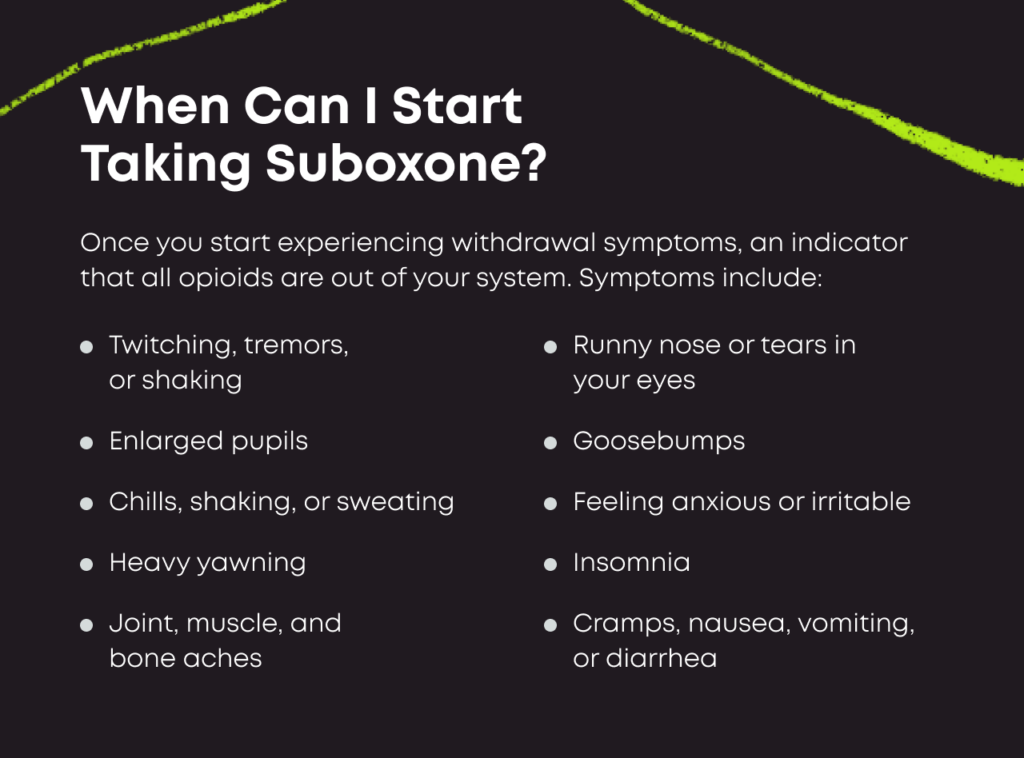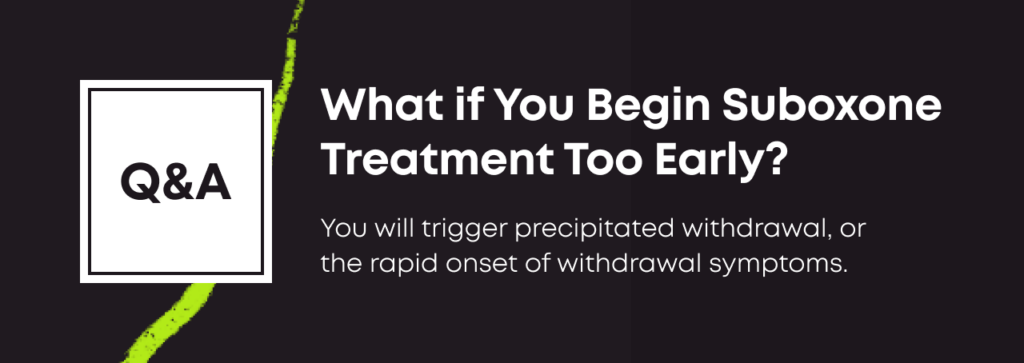You must wait between 12 and 72 hours after your last dose of opioids before taking your first dose of Suboxone. Your specific time frame depends on the opioids you took, your health and the severity of your opioid symptoms.
You won’t go through withdrawal alone. Your doctor will guide the process and ensure you take the right doses at the right time.

Key Facts About Starting Suboxone
Key Facts
- People taking short-acting opioids (like heroin or Vicodin) typically wait 12 to 24 hours after the last dose.[1]
- People taking long-acting opioids (like morphine or OxyContin) typically wait 36 hours after the last dose.[1]
- You must show signs of withdrawal (like dilated pupils or goosebumps) before starting Suboxone.
- Doctors often use the Clinical Opiate Withdrawal Scale (COWS) to measure withdrawal severity. A score of 8 to 11 on COWS indicates you can begin Suboxone.[2]

Starting Suboxone Requires Full Metabolization of Last Dose of Opioids
Before taking Suboxone, your body must fully metabolize the last dose of opioids you had taken. Otherwise, your first dose of Suboxone will make you feel very sick.
You’ll know it’s time when you experience opioid withdrawal symptoms, such as the following:[1]
- Twitching, tremors, or shaking
- Enlarged pupils
- Heavy yawning
- Joint, muscle, and bone aches
- Runny nose or tears in your eyes
- Goosebumps
- Cramps, nausea, vomiting, or diarrhea
- Feeling anxious or irritable
- Insomnia
You’re not required to experience significant symptoms. No one wants you to feel sick. But you must have some signs that your body has processed the last dose of opioids you took.
| Body System | Symptoms |
| Gastrointestinal | Nausea, abdominal cramps, vomiting, diarrhea |
| Nervous | Twitching, tremors, shaking |
| Musculoskeletal | Joint, bone or muscle pain |
| Mental | Anxiety, irritability, nervousness, insomnia |
| Visual | Large pupils, runny nose, weeping eyes, goosebumps |
How Do Suboxone Doctors Know When It’s Time to Start Suboxone?
Doctors who prescribe suboxone don’t guess when to start the medication. Instead, they use data to guide their decisions and ensure you’re not taking Suboxone too early. Two methods exist to guide them.
Understanding Timeframes
Interviews start this process. Doctors form a complete picture of your opioid use, and they use the information to build an individualized Suboxone induction plan.
Your doctor might ask the following questions:
- What opioids did you take regularly?
- Did you take other opioids too?
- How much did you take each time?
- How long did your use last?
- When did you take your last dose?
Be honest when answering these questions. Your doctor must understand your opioid use disorder to provide a withdrawal plan that’s safe and effective for your body.
Understanding the Clinical Opiate Withdrawal Scale (COWS)
The Clinical Opiate Withdrawal Scale (or COWS) is an 11-item screening tool doctors use to measure withdrawal symptoms.[3] The results can help your doctor understand when it’s time to start Suboxone and when you’ve reached the appropriate maintenance dose.
When doctors use COWS, they measure the following points:[3]
- Pulse rate
- Sweating
- Restlessness
- Pupil size
- Bone or joint aches
- Runny nose or watery eyes
- Gastrointestinal symptoms
- Tremor
- Yawning
- Anxiety or irritability
- Goosebumps on skin
Each symptom is scored from 0 (not present or normal) to 4 (high). Some symptoms (such as extreme GI upset or restlessness) can get scores as high as 5 if they’re severe.
Your total COWS score can help your doctor understand how your body is reacting to sobriety. Typically, scores of 8 to 11 indicate that it’s time to begin Suboxone therapy. If your score is lower than 8, your doctor might reassess your progress in two hours.[2]
How Many Hours or Days Should You Wait Before Beginning Suboxone?
The duration of wait time depends on which opioids you were taking. Some persist in your body longer than others do. The drugs you take can dictate how long you’ll wait before your first Suboxone dose.
How Long Will You Wait?
| Type of Opioid | Recommended Wait Time | Opioid Examples |
| Short-acting | 12 to 24 hours | Heroin, Percocet, Vicodin |
| Long-acting | At least 36 hours | Oxycontin, morphine |
| Maintenance medication | 48 hours or more | Methadone |
These are typical timelines. Know that your body is unique. You may need more or less time than we’ve listed here, and your doctor can help you determine an appropriate timeline.
What to Expect When Starting Suboxone Treatment
The first day of Suboxone treatment is exciting. You’re starting a new way of life. But it can also be uncomfortable. Plan to stay home from work for a day or two, so you can focus on your healing and recovery.
Starting Suboxone typically means following these steps:
- Stop taking opioids: Don’t take another dose of your drugs, and write down the date and time of when you last used.
- Watch for symptoms of withdrawal: Your pupils may widen, and you may break out in goosebumps. These early signs typically mean withdrawal is beginning.
- Score your symptoms: If your doctor is using the COWS method, you’ll score all the withdrawal signs you’re experiencing. You’ll report that grade to your doctor.
- Take your first Suboxone dose: When your withdrawal symptoms are moderately intense, you’ll take a Suboxone dose your doctor thinks is appropriate for your body.
- Score your symptoms: Within about two hours, you’ll use COWS again to see if your withdrawal symptoms are better or worse.
- (Optional) Repeat: If your COWS scores are still high, your doctor may increase your Suboxone dose and ask you to score symptoms again in two hours. You’ll repeat this step until you find the right dose.

What Happens if You Begin Suboxone Treatment Too Early?
Suboxone is a very safe and effective medication for opioid use disorder, but it’s also powerful. If you take Suboxone too soon, you could get very sick.
It is important to wait until your last opioid dose completely metabolizes out of your body before beginning Suboxone treatment. Buprenorphine binds more strongly to opioid receptors in the brain than other opioids. It can therefore replace other opioids on the receptors in your brain too quickly and trigger withdrawal.[4]
Understanding Precipitated Withdrawal
Precipitated withdrawal is the rapid onset of withdrawal symptoms, including pain, nausea, anxiety, goosebumps, and anxiety. About 9% of people taking buprenorphine products like Suboxone for the first time experience precipitated withdrawal.[5] With planning, you can avoid it.
Preparing for your first Suboxone dose is uncomfortable, and few people enjoy spending time shivering, shaking, and feeling nauseated. But if you reach for your Suboxone for relief, you’ll make things worse. Precipitated withdrawal will amplify your symptoms very quickly.
Always follow your doctor’s plans about when to start taking Suboxone. Together, you can create a schedule that might be a bit uncomfortable but certainly won’t be excruciating.
Frequently Asked Questions About Starting Suboxone
These are some of the questions that people often ask about when to start Suboxone:
Why do I have to wait to take Suboxone?
Suboxone contains buprenorphine and naloxone — two ingredients that can remove drugs like heroin from their receptors and plunge you into immediate (and uncomfortable) withdrawal. Waiting means letting your body process opioids naturally, so your Suboxone won’t make you sick.
Is 12 hours long enough to wait to take Suboxone?
It depends on the drugs you’ve been taking. People with a history of methadone use, for example, might need to wait much longer. Your doctor can help you create an appropriate timeline.
How long does it take for Suboxone to kick in?
It typically takes 20 to 60 minutes for Suboxone to kick in. But your age, weight, history of substance abuse, and other factors could make it work faster or slower for you.
How long does Suboxone last?
Suboxone timelines by dosage don’t vary. Most people feel Suboxone’s impact for about 24 hours.
How can I get emergency Suboxone?
If you’re wondering how to get emergency Suboxone, know you have options. You could visit an emergency room, urgent care clinic, or your doctor. You will need a prescription for the drug, so you should go somewhere with a qualified medical professional on staff.

Reviewed By Peter Manza, PhD
Peter Manza, PhD received his BA in Psychology and Biology from the University of Rochester and his PhD in Integrative Neuroscience at Stony Brook University. He is currently working as a research scientist in Washington, DC. His research focuses on the role ... Read More
- A Patient’s Guide to Starting Buprenorphine at Home. IT MATTRs. https://www.asam.org/docs/default-source/education-docs/unobserved-home-induction-patient-guide.pdf?sfvrsn=16224bc2_0. Accessed May 2023.
- Opioid Use Disorder: Medication-Assisted Treatment. Penn Medicine Formulary. https://penncamp.org/wp-content/uploads/2021/05/Opiate-Use-Disorder-Buprenorphine_Naloxone-Induction-Pathway.pdf. May 2021. Accessed April 2023.
- Clinical Opiate Withdrawal Scale. Journal of Psychoactive Drugs. https://nida.nih.gov/sites/default/files/ClinicalOpiateWithdrawalScale.pdf. June 20023. Accessed April 2023.
- Suboxone Sublingual Tablets. Medsafe, New Zealand Government. https://www.medsafe.govt.nz/Consumers/cmi/s/suboxone.pdf. July 2021. Accessed April 2023.
- Managing Opioid Withdrawal Precipitated by Buprenorphine with Buprenorphine. Drug and Alcohol Review. https://onlinelibrary.wiley.com/doi/full/10.1111/dar.13228. January 2021. Accessed April 2023.
Download Our Free Program Guide
Learn about our program, its effectiveness and what to expect
Related Content
Imagine what’s possible on the other side of opioid use disorder.
Our science-backed approach boasts 95% of patients reporting no withdrawal symptoms at 7 days. We can help you achieve easier days and a happier future.
